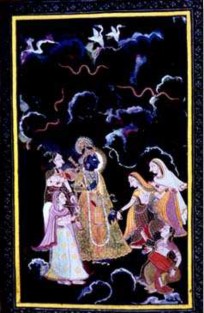Bundi painting

The Bundi style of painting is very close to the Mewar style, but the former excels the latter in quality. Painting in Bundi started as early as circa 1625 A.D. A painting showing Bhairavi Ragini, in the Allahabad Museum is one of the earliest examples of Bundi painting. Some examples are, an illustrated manuscript of the Bhagawata. Purana in the Kotah Museum and a series of the Rasikapriya in the National Museum, New Delhi.
A series of the Rasikapriya of the late 17th century, has a scene which represents Krishna trying to collect butter from a Gopi, but finding that the pot contains a piece of cloth and some other objects and no butter he rea1ises that he has been duped by the Gopi. In the background are trees and in the foreground is a river indicated with wavy lines. In the river are seen flowers and a pair of acquatic birds. The painting has a border in brilliant red colour. The peculiar characteristics of the Bundi painting, as evident in this
miniature, are the rich and glowing colours, the rising sun in golden colour, crimson-red horizon, overlapping and semi-naturalistic trees. The Mughal influence is visible in the refined drawing of the faces and an element of naturalism in the treatment of
the trees. The text is written in black against yellow background on the

top.
